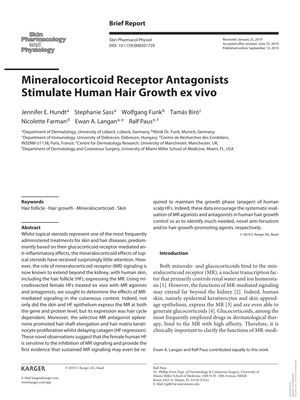TLDR Eplerenone, a mineralocorticoid receptor antagonist, was found to promote hair growth in human hair follicles.
The study from 2019 found that mineralocorticoid receptor (MR) antagonists, particularly eplerenone, can stimulate hair growth in human hair follicles (HFs) treated ex vivo. MR expression in the skin and HF epithelium was shown to be hair cycle-dependent, and eplerenone was observed to promote hair shaft elongation, increase hair matrix keratinocyte proliferation, and delay the catagen phase, suggesting a role for MR signaling in extending the anagen phase of hair growth. The research involved microdissected HFs from four female participants aged 41–66 years, treated over 7 days. The document also discusses the potential of MR antagonists like spironolactone, which has been noted to have location-dependent effects on hair growth, and the need for further research into topical MR ligands, their sex and skin location-dependent effects, and their interaction with other receptors in hair biology. Side effects such as hyperkalemia and breakthrough bleeding with spironolactone were mentioned, indicating that topical applications could be more clinically attractive. The study was supported by the University of Lübeck and the NIHR Manchester Biomedical Research Centre and followed ethical guidelines, including informed consent.
8 citations
,
October 2016 in “Journal of Investigative Dermatology” MR antagonists may improve skin health and wound healing, especially in aging.
 130 citations
,
August 2015 in “Experimental Dermatology”
130 citations
,
August 2015 in “Experimental Dermatology” Human hair follicle organ culture is a useful model for hair research with potential for studying hair biology and testing treatments.
 89 citations
,
November 2014 in “International Journal of Nanomedicine”
89 citations
,
November 2014 in “International Journal of Nanomedicine” Using nanostructured lipid carriers to deliver spironolactone could improve treatment for hair loss.
 46 citations
,
September 2013 in “PLOS ONE”
46 citations
,
September 2013 in “PLOS ONE” Thyrotropin-Releasing Hormone helps heal wounds in frog and human skin.
 40 citations
,
November 2009 in “Experimental Dermatology”
40 citations
,
November 2009 in “Experimental Dermatology” The mineralocorticoid receptor may play a role in skin and hair health and could be a new target for treating related disorders.
 67 citations
,
August 2007 in “American Journal of Pathology”
67 citations
,
August 2007 in “American Journal of Pathology” Overexpressing the mineralocorticoid receptor in mouse skin causes skin thinning, early skin barrier development, eye issues, and hair loss.
46 citations
,
January 2000 in “The Journal of Clinical Endocrinology and Metabolism”
 November 2020 in “Elsevier eBooks”
November 2020 in “Elsevier eBooks” Antiandrogens and androgen inhibitors like spironolactone, finasteride, and dutasteride can treat hair loss and skin conditions, but they have risks and side effects, including potential harm to pregnant women and risks of cancer and heart issues. Herbal remedies also have antiandrogenic effects but lack safety validation.
 40 citations
,
November 2009 in “Experimental Dermatology”
40 citations
,
November 2009 in “Experimental Dermatology” The mineralocorticoid receptor may play a role in skin and hair health and could be a new target for treating related disorders.
 18 citations
,
May 2020 in “Biomolecules”
18 citations
,
May 2020 in “Biomolecules” Spironolactone, a heart and liver drug, has new uses including cancer treatment, viral infection prevention, and skin condition improvement.
 48 citations
,
February 2013 in “Molecular and Cellular Endocrinology”
48 citations
,
February 2013 in “Molecular and Cellular Endocrinology” The protein StAR is found in 17 different organs and can affect hair loss and brain functions, but its full role is not yet fully understood.
 October 2015 in “Elsevier eBooks”
October 2015 in “Elsevier eBooks” Spironolactone can cause side effects like high potassium levels and breast enlargement, and patients need careful monitoring.









